Types of Assemblage Point Shifts
A centrally located Assemblage Point is positioned inside the chest, close to the root of the fourth human chakra. This means that it is in front of the fourth and fifth thoracic vertebrae, under the region of the trachea branching into the two bronchi of the lungs.
The energy lines are compressed into a tight bundle by what may be reasoned as, a toroidal type of structure. The toroidal structure transforms energy and information from the currents of the Assemblage Point energy lines and distributes these by means of the human energy field into and around the physical body (see the scientific document `Toroidal Structures’ in the Appendix).
There are three different classifications of types of movements or shifts that can occur with the Assemblage Point, and these are:
1) A movement or change of the entry and exit angle of the Assemblage Point energy lines.
2) A shift of the Assemblage Point’s toroidal structure to a detrimental or beneficial location.
3) A shift in depth of the Assemblage Point’s toroidal structure, usually forwards.
1) A movement of the Assemblage Point’s entry angle can happen to most of us. For example, if we are intimidated or overburdened, we can develop hypertension or hypotention. The Assemblage Point’s entry angle can move to the right side, upwards or downwards and it can take hours, several days or weeks for the entry angle to drift back to the original location. The person will gradually feel better by degrees as their neurological system re-balances. This movement is a change in the Assemblage Point’s entry angle on the Z axis. The central core of the Assemblage Point, the toroidal structure, does not change its location.
2) A shift of the toroidal structure is distinctly different from a movement or change of the entry angle. The Assemblage Point toroidal structure becomes dislodged and moves to a different location in the body. This can occur with a traumatic incident of any kind. Generally, depending on the measure of the dislodgement the neurological system can stay unbalanced. Under these circumstances the Assemblage Point toroidal structure does not return to its original location naturally and the recipient may become ill as a result. A shift is a change in the location on the X and Y axes. The entry angle on the Z axis will almost certainly change at the same time.
3) A shift in depth occurs only under special circumstances. Here, the Assemblage Point’s toroidal structure energy moves closer to the surface of the chest or even outside on the surface of the chest. This is a powerful experience that reinforces and stabilises the Assemblage Point location. The depth of the shift depends on the skill and available free energy and `intent’ of the person conducting the shift and the amount of energy that the person receiving the shift accumulates, when performing the essential pre-shift breathing discipline. This type of shift increases the energy potential of the Assemblage Point. The vortex of the toroidal structure becomes concentrated into a smaller diameter. The core circumference becomes brighter in appearance, while the core’s central cavity of the Assemblage Point’s energy bundle becomes darker in appearance. An analogy may be thought of or `seen’ as akin to the `Black Hole’ in the centre of a galaxy. A shift in depth is a movement of the toroidal structure of the Assemblage Point outwards away from the centre of the body along the Z axis.
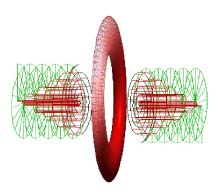
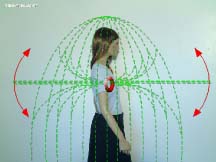
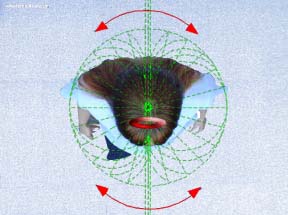
Fig. 7:1. Toroidal Structure of the Assemblage Point.
Fig. 7:2 a & b. A movement of the Assemblage Point is a change in the `entry’ and `exit’ angle that is accompanied by or caused by a change of mood (a = up or down, X Axis & b = left or right, Y Axis).
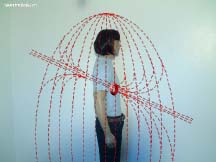
Fig. 7:3. A shift in the Assemblage Point is a dislocation of the Toroidal Structure itself to a new detrimental or beneficial location (X & Y Axis).
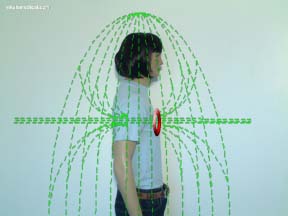
Fig. 7:4. Shifts in depth outwards along the Z axis.

Fig. 7:5. Super massive Black Hole (courtesy of NASA).
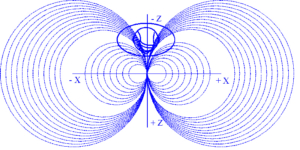
Fig. 7:3. A shift in the Assemblage Point is a dislocation of the Toroidal Structure itself to a new detrimental or beneficial location (X & Y Axis).
Realignment Aids
The average healthy person’s Assemblage Point enters just inside the right side of the chest and exits near the right shoulder blade in the centre of the back. A large framed strong healthy centered person with training can shift and centralise Assemblage Points by slapping or thumping the rear location or pivot point using the palm of the right hand, at the same time, making a clenched fist with the left hand, which is placed on the centre of the subject’s chest. The technique requires great personal energy, and also the full cooperation of the person receiving the shift.
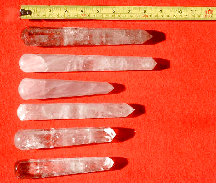
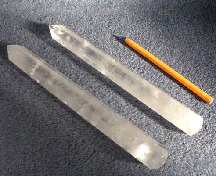
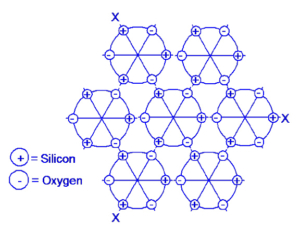

Fig. 7:7 a & b. Quartz crystals with polished domed ends shown against a tape measure and ballpoint pen for size scale.
Fig. 7:8 a & b. Negative and positive polarisation of the electrons of quartz. Polarisation = oxygen negative and silicon positive.
However it is much easier and requires less personal energy if a specially designed shifting aid or tool is used. American Indian tribal medicine men use a specially machined and polished quartz crystal to capture the energy lines of the Assemblage Point and move it to the desired location.
Piezo electricity relates to the electrical charges in certain crystals when they are subjected to manual pressure (squeezing and tapping etc.) and conversely to the conversion of electrical stress into mechanical strain. Piezo is from a Greek word meaning pressure. The piezo-electrical effect of quartz crystal is a scientific principle. It is used in television, radio and medical equipment; for example, ultra sound and ultra sonic therapies make use of the natural piezo-electrical effect of quartz and other crystalline substrates. For the piezo-electrical effect to function for these purposes, the crystal must be connected into an electronic circuit with wires so that its many properties can be exploited. Liberating the electrical charges when a crystal is stressed is a function of electrical asymmetry within the atomic groups of which the crystal is built. Inside the crystal the constituent atoms are arranged in a definite pattern that is repeated at distances having atomic dimensions. Silicon and oxygen are arranged with respect to each other to produce silicon dioxide (Si02). Positive charges are shown carried by silicon atoms (+), negative charges by double oxygen atoms (-).
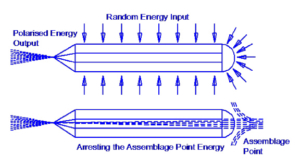
Fig. 7:9. Using a quartz crystal with a polished domed end to arrest the Assemblage Point energy lines.
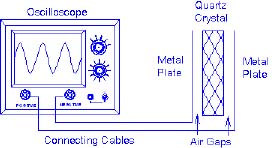
Fig. 7:10. The dielectric resonance properties of crystalline substrates induce a voltage into adjacent metal plates.
Not so well known and often denied by the uninformed, is that resonating crystalline substrates dissipate their energy by dielectric transference, inducing it into adjacent objects and the environment. The electrons in adjacent substrates, such as living tissue, will resonate in sympathy when in close proximity to a resonating crystalline substrate. The frequency, intensity and quality of the energy induced into adjacent objects and the environment are dictated by the type, size, colour and atomic composition of the crystalline substrate used. Also, the frequency and intensity of the transferred energy can be electronically increased and modulated with medically desirable electromagnetic frequencies.
The natural polarizing properties of quartz are ideally suited for Assemblage Point manipulation. The drawings illustrate the principles of arresting or capturing the Assemblage Point energy. For consistent results observe the following minimum standards for the crystal. The crystal should weigh 200 grams or more, have a length of a least 18 centimeters and a diameter of 3 centimeters or more. The crystal must have a ground and polished domed end. It should be as clear as possible and must have a well-defined point. The point should have at least three perfect triangles among its six facets and it must be energetic and dynamic. To check this, hold the crystal with your right hand and direct the point at the palm of your left hand. You should feel a breeze of cool, tingling energy penetrating the skin of your left hand where the crystal is pointing.
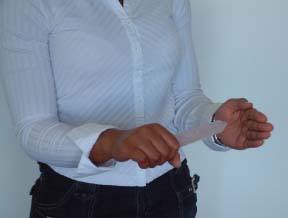
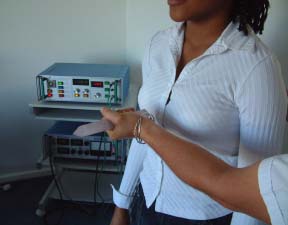

Fig. 7:11 Feeling for the energy breeze emitted from the point of a dynamic or active quartz crystal.
Fig. 7:12 a & B. The correct way to hold a quartz crystal for shifting the Assemblage Point either by using the `Sliding Shift’ or Stage Shifting method, always use your left hand and stand on the left side of your subject.
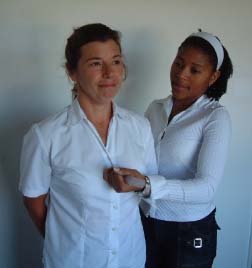
Fig. 7:13. The Sliding Sift can be performed without removing clothes, however only a light cotton vest or shirt should be worn. Synthetic cloths hold static electricity and they along with metal lingerie support stays can interfere with the locating and shifting process
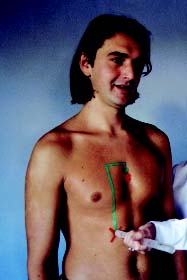
Fig. 7:14. The Sliding Sift is easily performed without clothes, lubricate the polished dome end of the crystal with one drop of olive oil so that it does not stick to the subject’s skin.
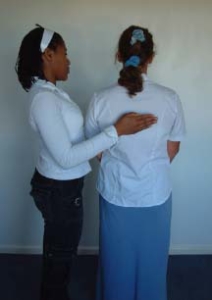
Fig. 7:15. Using the palm of a cupped right hand to slide shift the Assemblage Point rear location upwards. If performing a Stage Shift, use your right hand (flat inside finger parts only) to tap or slap the rear location.
Correcting the Assemblage Point takes about five minutes and procedures are painless. The experience can be exhilarating and stabilising. For some people with health problems, the experience can produce a profound relief. Frequent correction to the centre can significantly improve mental and physical efficiency. For personal and group development purposes it can be shifted monthly. It can also be centralised before important meetings or after stressful events. Sports and other team activities can benefit if all members are given the same alignment, in particular if they have experienced a series of defeats.
Realignment Using The Sliding Shift
The following procedures have been developed over many years and when acquiring the skills they should be rigidly adhered to so as not to develop any bad habits. Shifting Assemblage Points is a developed skill and requires practice. Shifting the Assemblage Point by sliding it from one location to another is the easiest and most straightforward method. It is the preferred method for training purposes and best practised with friends and colleagues or in a group workshop situation. The subject or patient must cooperate. This method has some disadvantages. The subject must remove the clothing from the chest area. Using it on female patients whose Assemblage Point location has dropped below their breast can be difficult, sliding or manipulating a dropped Assemblage Point up across a female breast is tricky, but achievable.
1. Find the subject’s Assemblage Point location and entry angle by using the instructions in the previous chapter. Mark the locations on the chest and back with a marking pen or small self adhesive labels.
2. Instruct the subject to stand upright looking straight ahead.
3. Stand facing the left-hand side of the subject’s body. Holding the quartz crystal in your left hand, place the polished, domed end on the precise location of the subject’s Assemblage Point where it enters the chest.
4. Use the palm of your right hand to cover and slide the rear location around the shoulder blade area.
5. Instruct your subject to take three deep breaths, slowly in through the nose and out of the mouth. Make sure that they are really deep, if not get them to take three more or, as many that are necessary to achieve full expansion of their lungs and chest cavity. Between each inhalation and exhalation the subject should pause for one second to allow biological energy to accumulate inside their chest and torso. Inhale to the count of seven, pause one count, exhale to the count of seven, pause for one count, inhale to the count of seven, and so on for three full deep breath cycles (refer to the drawings and photographs provided below).
6. On the third breath, when the chest is expanded and the lungs are full with air, instruct your subject to hold their breath in. Next instruct them to contract his sphincter and other muscles in the anus and genital area, and keep them contracted. Then at the same time instruct them to half swallow and close the throat (head upright and the chin tucked back).7. This effectively closes the upper and lower exit and entry gateways to the body. With the retained breath and closed gateways, energy pressure builds up and loosens the subject’s energy field from his physical body. This situation will allow you to slide the Assemblage Point to the central location using a quartz crystal. Most subjects can hold their breath for five or ten seconds and this is sufficient time.
8. Using the quartz crystal, slide your subject’s Assemblage Point to the centre of the chest. Simultaneously use the palm of your right hand to drag the rear location into the centre between the shoulder blades. Twist the crystal half a turn and remove it from his chest. Simultaneously, tap the subject lightly on the top of his head with the palm of your right hand, then tell him to breathe normally.
The shift should be in the directions shown in the drawings. It helps to lubricate the domed end of the crystal with a fine vegetable oil so that it slides easily over the skin without sticking.
Sometimes, when shifting the Assemblage Point, some subjects may not be able to maintain holding the throat or the sphincter muscles closed. Or they will fail to retain their breath. If this occurs, the Assemblage Point may be lost at any point along the shifting path. This can happen. In such cases, the Assemblage Point location and entry angle must be found again and the shifting procedure repeated.
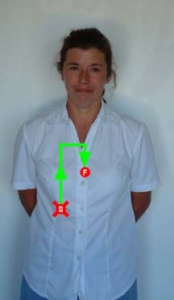
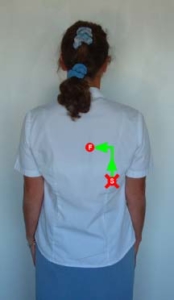
Fig. 7:16 a & b. A) For example: If the Assemblage Point is in a low location around position `S’, Start by placing the domed end of the quartz crystal directly on the exact location `S’. (Note. The overlaid direction indicators are enlarged for clarity).
B) While the subject is still holding their breath with their throat and sphincter muscles closed, deliberately and firmly slide the crystal up and then over to the centre line and then down to finish at the centre of the chest at `F’, at the same time, using your right hand placed firmly on the rear location, slide it up and over to the centre of their back.
C) When at the centre `F’, twist the crystal half a turn clockwise and remove it from the subject’s chest, at the same time using your right hand (flat inside finger parts only), gently but firmly tap you subject on the crown of their head and instruct them to breath freely. The tap on the head anchors or sets the new position.
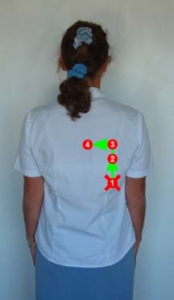
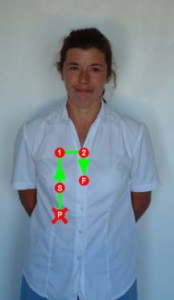
Fig. 7:17 a & b. A) If the Assemblage Point is in a low location around position marked `P’, place the quartz crystal at the front around point `S’ (start), use your right hand to knock or slap the rear location at `1′. (Note. The overlaid direction indicators are enlarged for clarity).
B) The Assemblage Point will jump upwards from the low location and latch onto the crystal at position `S’. Quickly move the crystal up to Stage `1′ at the front and thump the back location at `2′. The Assemblage Point will jump up to Stage `1′.
C) Rapidly move the crystal across to Stage `2′ and thump the back location at `3′.
D) Without any hesitation and while the subject is still holding their breath with the throat and sphincter muscles closed, move the crystal down to the centre to finish at `F’ and twice swiftly thump the rear location at `4′ then twist the crystal half a turn and remove it from subjects’ chest, at the same time using your right hand (flat inside finger parts only), gently but firmly tap you subject on the crown of their head and instruct them to breath freely. The tap on the head anchors or sets the new position.
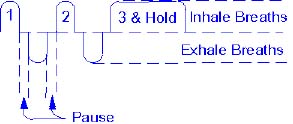
Fig. 7:18. Schematic illustrating the 3 breath cycles with pauses between breaths to the retention phase that enables the Assemblage Point to be shifted.
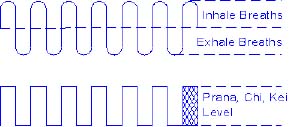
Fig. 7:19. Schematic illustrating how repeated breath cycles without pauses between breaths does not accumulate biological energy.
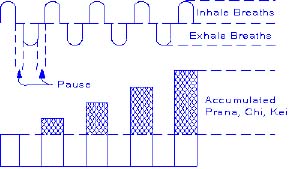
Fig. 7:20. Two Schematics illustrating how repeated breath cycles with pauses between breaths accumulate biological energy.
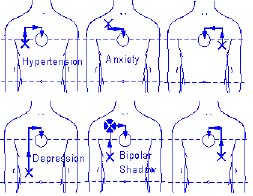
Fig. 7:21. Schematic illustrating the correct direction to shift the Assemblage Point from various detrimental locations
Instruct your subject beforehand as follows, so that they understand and expect what you are going to ask them to do.
“I need your cooperation and assistance in order for you to accumulate the biological energy needed so that I can move your Assemblage Point. I am going to instruct you to take three deep breaths, through your nose, pausing between each breath. When you have taken your third breath, I will ask you to hold your breath and at the same time you must squeeze or hold tightly the muscles in your anus and genitals, as if you are anxious to use the toilet. This will prevent the accumulated energy from escaping from your body. I will then ask you to half-swallow and keep your throat closed and hold on to your breath and I will shift your Assemblage Point”.
Once the patient or subject has understood this, proceed to shift their Assemblage Point instructing them, by reading to them the following:
“Please stand upright, arms relaxed by your sides, with your back and shoulders straight and chest pushed out. Relax, place your feet slightly apart. Now relax more and feel and be aware of the weight of your body standing on the floor. Breathe normally and look straight ahead.”
“Slowly take a deep breath through your nose, and fill your lungs as much as you can. Now pause. Breathe out as slowly through your mouth as much as you can to completely empty your lungs. Now pause”. (One completed breath cycle)
“Inhale slowly and deeply. Now pause. Exhale slowly and deeply. Now pause”. (Two completed breath cycles.)
“Inhale slowly and deeply. Now pause. Exhale slowly and deeply. Now pause. (Three completed breath cycles.) Inhale, now hold your breath and squeeze the muscles tight in your anus and genitals. Now half-swallow and keep your throat closed and hold on to your breath, do not release your breath until I tell you to”.
At this point you can then shift the Assemblage Point to a new location by the sliding or stage shifting methods described below.
With the following method, the subject can keep his vest on. Instead of sliding the Assemblage Point towards the centre, shifting is done in one or several stages or short steps depending on the distance of misalignment. The rear location or pivot point is dislodged with a firm push or slap to the subjects’s back using the palm of your right hand. Shifts of a short distance require only one stage and two pushes. Large distances may require three stages and four pushes to shift it to the centre. The rest of the procedure is the same as for the sliding method above. This method of shifting has another advantage over the previous method. The Assemblage Point can be also shifted in depth. The depth is determined by the force of the shift and the amount of biological energy that is accumulated with the breathing.
1. Use two small adhesive labels or a pen to mark the front and rear Assemblage Point locations. Plan the number of stages you will use to move the Assemblage Point to the centre normally not more than four.
2. Use your left hand to position the crystal on the first stage. Firmly instruct the subject through Steps 2 to 6 as in the sliding shift above and by reading aloud to them the notes in: “How to Instruct Your Subject”, above. When the subject is holding his breath and the sphincter muscles and throat are closed, give a firm push or slap to the Assemblage Point rear location with the heel or palm of your right hand. The Assemblage Point will jump and relocate at the crystal. Large framed, recalcitrant or strong-willed subjects often require a firm shove or slap or thump with the palm of your right hand on the rear pivot point to dislodge it.
3. Rapidly move the crystal to stage 2 and again shove or slap the rear location. Long shifts may require a third stage, so push the rear location again to shift the Assemblage Point to the third stage. The subject must continue to hold his breath throughout. You only have a few seconds before he will need to breathe again, therefore you must be practised and swift.
4. When you arrive with the crystal at the centre give a final firm push between the shoulder blades and remove the crystal from the subject’s chest with a half clockwise twist. Simultaneously, using the palm and four fingers of your now free right hand, tap the subject lightly on the head and instruct him to breathe normally.
Allow the subject a few moments to rest. Always re-check the Assemblage Point location, making sure that it has not been left behind at one of the stages. If necessary, repeat the procedure. After the shift, get the subject to lie down, breathe freely and relax for about fifteen minutes. This helps to stabilise and embed the new location.
It is helpful to familiarise the subject with his original Assemblage Point location and the new position after the shift. Touching or pushing the spot with your finger will cause the skin to redden more than skin elsewhere on the chest. The spot is often tender, sore or uncomfortable. Pushing it causes the subject a feeling of slight unease that can pass deep into the chest, often right through to their back. Once the Assemblage Point has been moved to a central position, these sensations will vanish from the original position and migrate to the new location. Helping subjects to take conscious note of the new position will allow them to keep track of their Assemblage Point, and arrange to have it corrected in the future, should it move too far from the centre.
Patients with low locations will often react physically when their Assemblage Point is found. For example, they may start to tremble or shake as you move your right hand across their Assemblage Point. Sometimes they complain of a long-standing pain in their back or associated pains elsewhere when you move your hands into and across the energy lines of their Assemblage Point. Therefore, do not practice on patients – learn the methods with your friends and colleagues first. When you are confident that you can find the Assemblage Point location and entry angle efficiently, then progress to work with patients.
Clinical corrections associated with health problems are best achieved with two experienced professionals. It should be backed up with professional patient management care and generally only be carried out by medically qualified personnel. One practitioner is required to locate the Assemblage Point and the second to do the shifting and each will double check the other’s work. However, if one is very confident that the location of a patient’s Assemblage Point is in a detrimental location, then one should not be discouraged from attempting to correct it.
As mentioned previously, psychiatric patients suffering from schizophrenia or manic depression can often have an “energy shadow” and “split” Assemblage Point locations. The dominant Assemblage Point must be located and shifted to the secondary split or shadow location. Both are then picked up with the crystal and shifted to the centre. Splits and shadows are not easy to deal with and considerable experience in locating and shifting Assemblage Points is required to be effective. Patients should be reassessed and their Assemblage Point corrected within ten to fourteen days of their first shift. It should then be corrected monthly until their location stabilises. Patients taking antidepressants, tranquillisers or other types of drugs, may require lower dosages or modified drug management following realignment.
Patients withdrawing from non-prescribed drugs or substances may require daily shifting for one week or more until their biological and nervous systems adjust and stabilise. With old or frail patients and young children, shifting their Assemblage Point manually is neither practical nor advisable. In any event very infirm patients may not be able to cooperate or breathe properly, therefore the above outlined procedures cannot be applied and other methods must be used as outlined below.
The Assemblage Point in babies and young children has no fixed location. It is unstable and can move freely. As a child’s personality and internal dialogue develop, the Assemblage Point begins to be fixed. Ideally, adolescents and juveniles should be allowed to develop and fix their own location, without interference other than the normal family and educational procedures. As with adults, children with serious misalignment of their Assemblage Point do not find it easy to integrate with their peers. Some youngsters who have experienced accidents, intimidation, bullying, drug abuse, illness, or psychological problems are likely to have misalignment problems. In such cases, any educational or therapeutic methods that will stabilise and centralise their Assemblage Point will help their development. Children over 10 years of age with health problems or symptoms caused by misalignment can gain substantial benefits from the shifting and realignment procedures coupled with other supportive therapy.
Other people, from differing backgrounds and having other expertise and goals, can now utilise these methods in pursuit of their personal growth, professional development and areas of research.
For example, education, professional sports, labour and team management, politics, prisoner reform and rehabilitation, social services, armed combat personnel rehabilitation, substance abuse, national security, psychology, psychiatry, counseling, marriage guidance, relationships, yoga, mystical disciplines, martial arts, the arts, rapid learning, the list of applications is exhaustive.
Not only does the discovery of the Assemblage point prove to the sceptics and agnostics that there is more to us humans than mere chemicals, blood, flesh and bones, but, it also has profound benefits for our wellbeing and development.
As a stable and correctly located Assemblage Point increases health and efficiency, aside from the medical, psychological and spiritual benefits, the wider professional application of the Assemblage Point technique into other areas will greatly benefit humanity. It will save and generate more money than can currently be estimated.
For comprehensive information and instructions on locating and correcting the location and entry angle of the Assemblage Point, please refer to Ebooks and paperbacks entitled:
1) ‘The Catalyst Of Power – Assemblage Point of Man’
2) ‘Naked Spirit – The Supernatural Odyssey’